A Case Study: Digital Technologies' Impact on M&S Business Activities
VerifiedAdded on 2020/06/04
|27
|5039
|49
Report
AI Summary
This report presents a comprehensive case study on the impact of digital technologies on Marks and Spencer's (M&S) business activities. It begins with an introduction that highlights the crucial role of digital technologies in modern business operations, particularly in enhancing service quality and efficiency. The report outlines the aims and objectives of the project, focusing on understanding the significance of digital technologies for various departments within M&S. It details the project management plan, including cost estimations, time frames, and risk assessments, along with the use of tools like Work Breakdown Structure, Gantt charts, and network diagrams. The research methodology involves primary and secondary data collection, with a focus on a survey of M&S managers to gather their views on digital technologies. The report also includes a questionnaire used for data collection. The report analyzes the current state of M&S's business operations, the impact of digital techniques, and the departments responsible for the project. It evaluates the implementation of digital technologies, customer satisfaction, and forecasting further business activities using digital techniques. Finally, the report concludes with recommendations for managing projects and leveraging digital technologies to improve M&S's effectiveness and competitiveness.
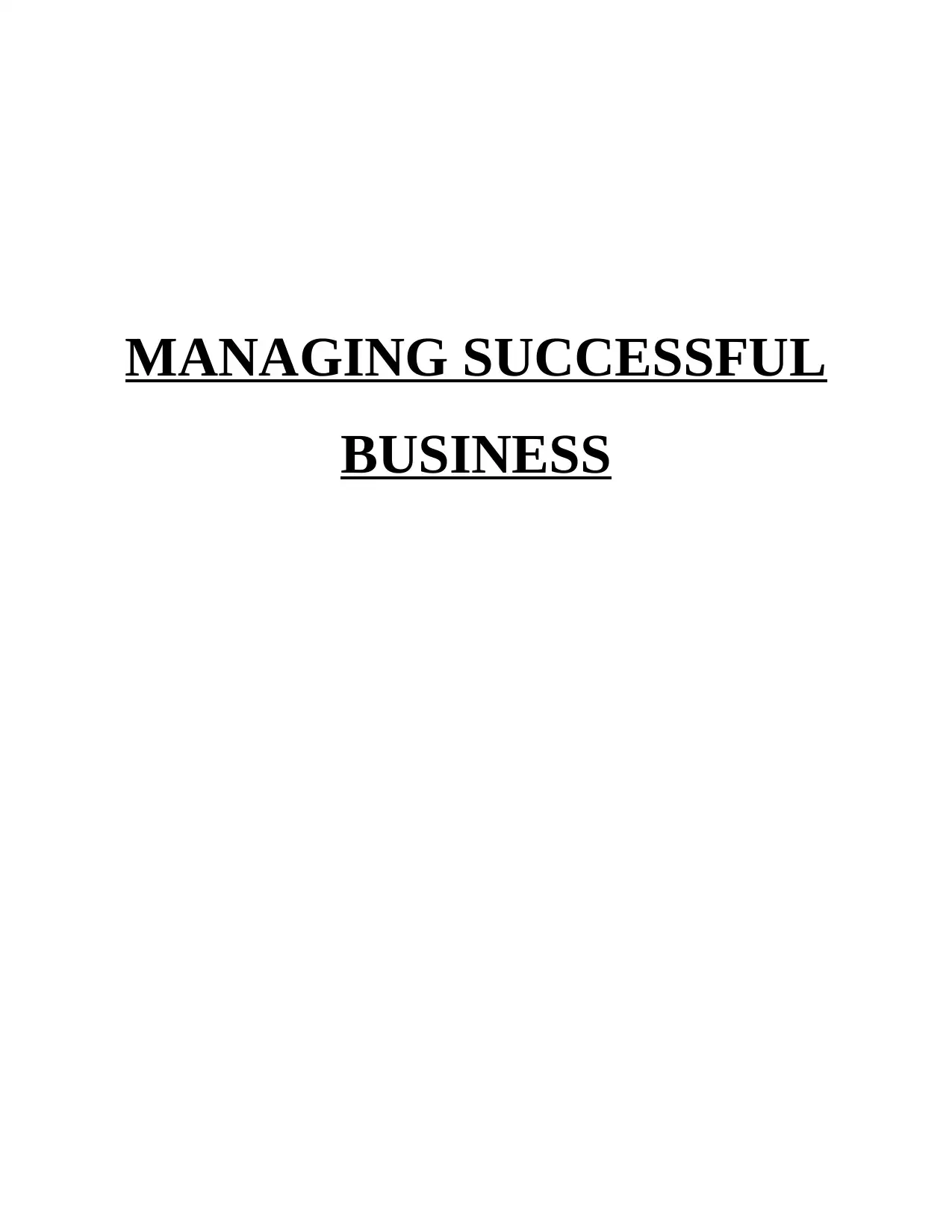
MANAGING SUCCESSFUL
BUSINESS
BUSINESS
Paraphrase This Document
Need a fresh take? Get an instant paraphrase of this document with our AI Paraphraser
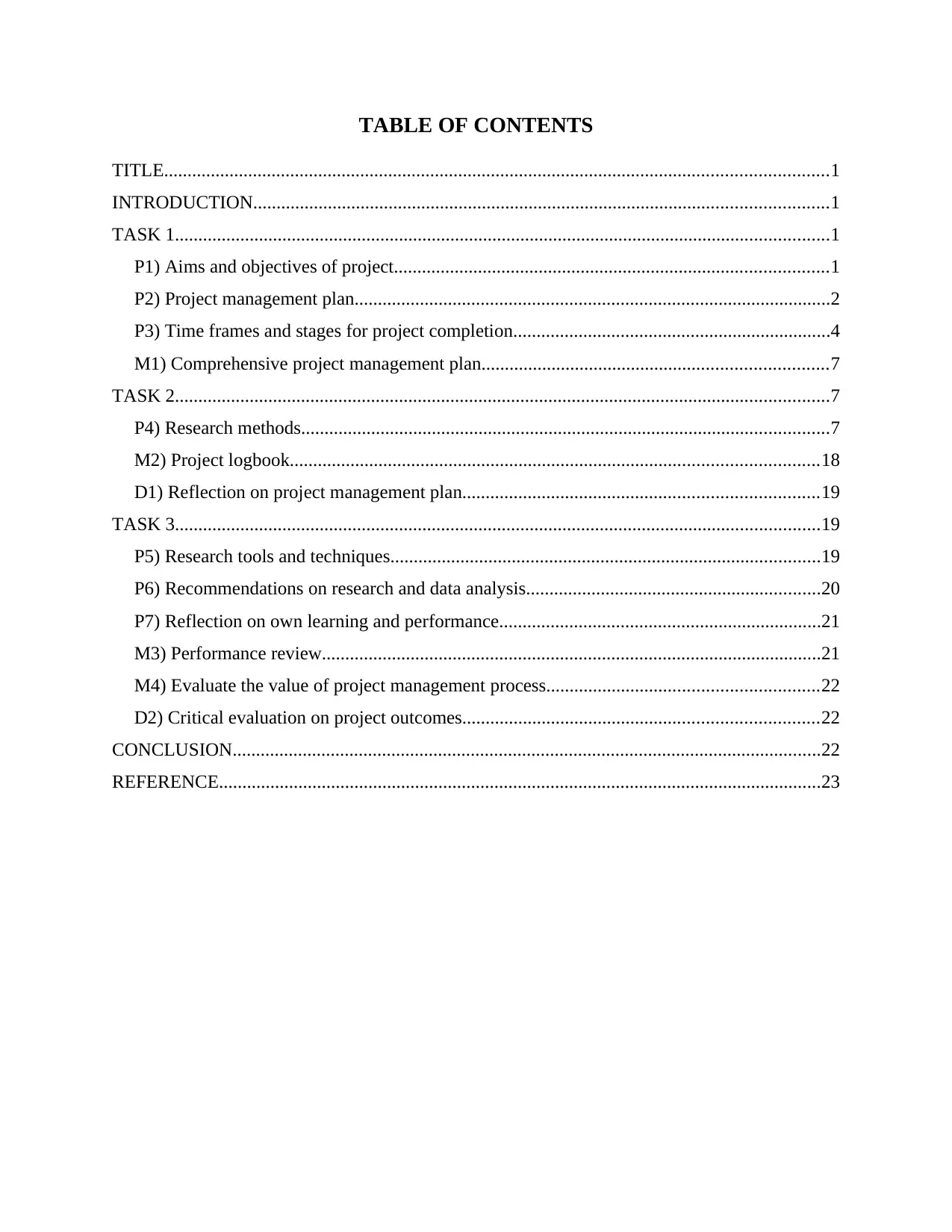
TABLE OF CONTENTS
TITLE..............................................................................................................................................1
INTRODUCTION...........................................................................................................................1
TASK 1............................................................................................................................................1
P1) Aims and objectives of project.............................................................................................1
P2) Project management plan......................................................................................................2
P3) Time frames and stages for project completion....................................................................4
M1) Comprehensive project management plan..........................................................................7
TASK 2............................................................................................................................................7
P4) Research methods.................................................................................................................7
M2) Project logbook.................................................................................................................18
D1) Reflection on project management plan............................................................................19
TASK 3..........................................................................................................................................19
P5) Research tools and techniques............................................................................................19
P6) Recommendations on research and data analysis...............................................................20
P7) Reflection on own learning and performance.....................................................................21
M3) Performance review...........................................................................................................21
M4) Evaluate the value of project management process..........................................................22
D2) Critical evaluation on project outcomes............................................................................22
CONCLUSION..............................................................................................................................22
REFERENCE.................................................................................................................................23
TITLE..............................................................................................................................................1
INTRODUCTION...........................................................................................................................1
TASK 1............................................................................................................................................1
P1) Aims and objectives of project.............................................................................................1
P2) Project management plan......................................................................................................2
P3) Time frames and stages for project completion....................................................................4
M1) Comprehensive project management plan..........................................................................7
TASK 2............................................................................................................................................7
P4) Research methods.................................................................................................................7
M2) Project logbook.................................................................................................................18
D1) Reflection on project management plan............................................................................19
TASK 3..........................................................................................................................................19
P5) Research tools and techniques............................................................................................19
P6) Recommendations on research and data analysis...............................................................20
P7) Reflection on own learning and performance.....................................................................21
M3) Performance review...........................................................................................................21
M4) Evaluate the value of project management process..........................................................22
D2) Critical evaluation on project outcomes............................................................................22
CONCLUSION..............................................................................................................................22
REFERENCE.................................................................................................................................23

INDEX OF TABLES
Table 1: Cost estimation..................................................................................................................2
Table 2: Time frame for project.......................................................................................................3
Table 3: Time scale for project........................................................................................................4
Table 4: Time schedule....................................................................................................................6
Table 1: Cost estimation..................................................................................................................2
Table 2: Time frame for project.......................................................................................................3
Table 3: Time scale for project........................................................................................................4
Table 4: Time schedule....................................................................................................................6
⊘ This is a preview!⊘
Do you want full access?
Subscribe today to unlock all pages.

Trusted by 1+ million students worldwide
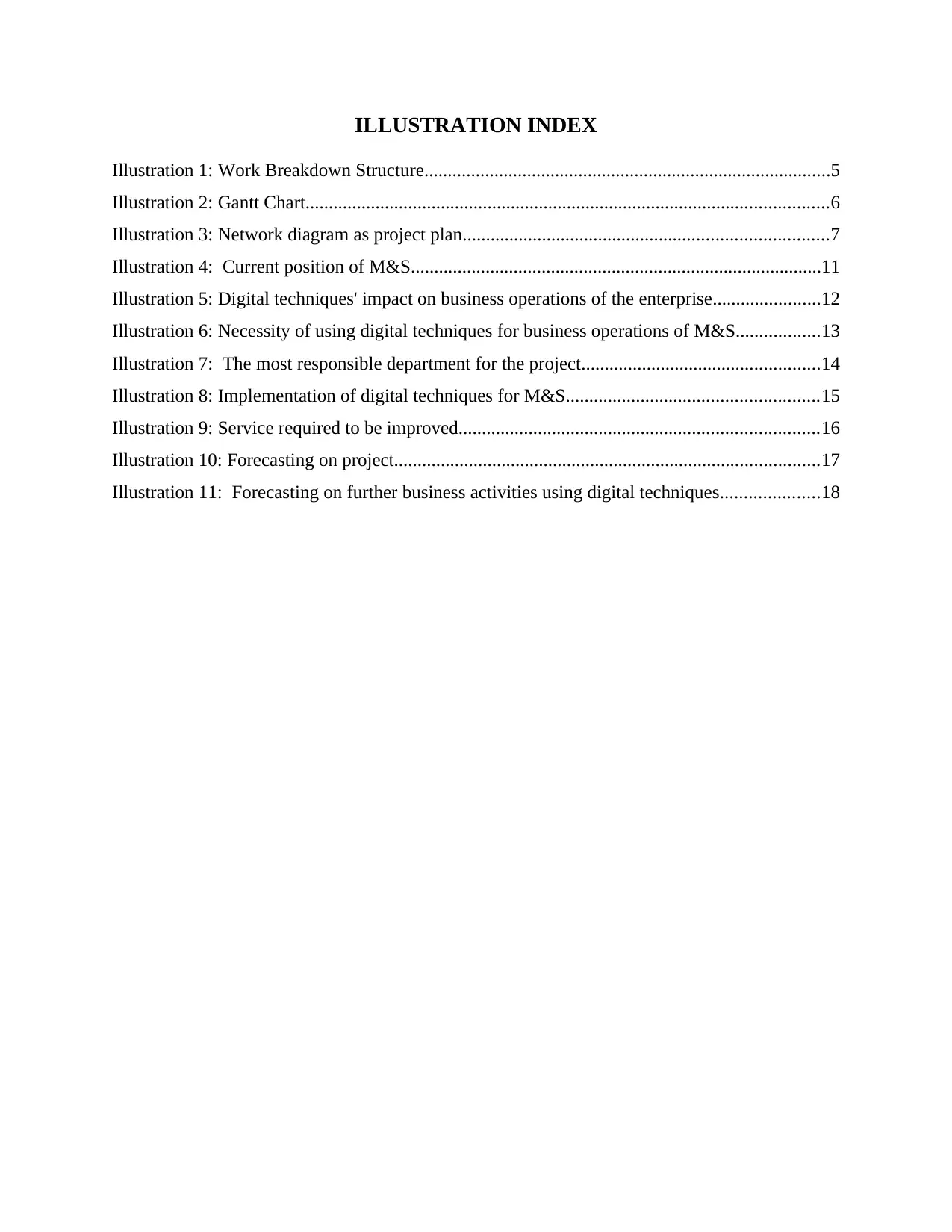
ILLUSTRATION INDEX
Illustration 1: Work Breakdown Structure.......................................................................................5
Illustration 2: Gantt Chart................................................................................................................6
Illustration 3: Network diagram as project plan..............................................................................7
Illustration 4: Current position of M&S........................................................................................11
Illustration 5: Digital techniques' impact on business operations of the enterprise.......................12
Illustration 6: Necessity of using digital techniques for business operations of M&S..................13
Illustration 7: The most responsible department for the project...................................................14
Illustration 8: Implementation of digital techniques for M&S......................................................15
Illustration 9: Service required to be improved.............................................................................16
Illustration 10: Forecasting on project...........................................................................................17
Illustration 11: Forecasting on further business activities using digital techniques.....................18
Illustration 1: Work Breakdown Structure.......................................................................................5
Illustration 2: Gantt Chart................................................................................................................6
Illustration 3: Network diagram as project plan..............................................................................7
Illustration 4: Current position of M&S........................................................................................11
Illustration 5: Digital techniques' impact on business operations of the enterprise.......................12
Illustration 6: Necessity of using digital techniques for business operations of M&S..................13
Illustration 7: The most responsible department for the project...................................................14
Illustration 8: Implementation of digital techniques for M&S......................................................15
Illustration 9: Service required to be improved.............................................................................16
Illustration 10: Forecasting on project...........................................................................................17
Illustration 11: Forecasting on further business activities using digital techniques.....................18
Paraphrase This Document
Need a fresh take? Get an instant paraphrase of this document with our AI Paraphraser
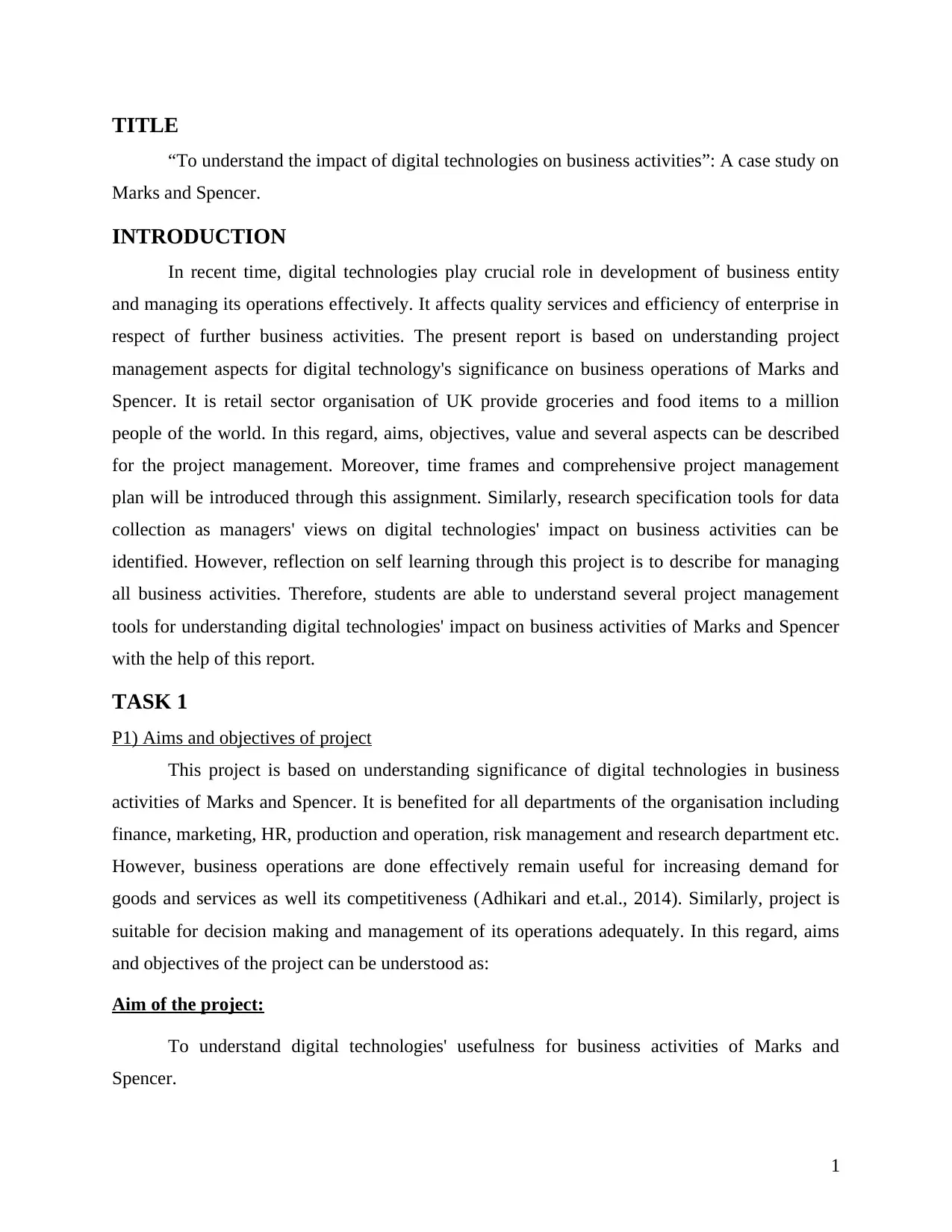
TITLE
“To understand the impact of digital technologies on business activities”: A case study on
Marks and Spencer.
INTRODUCTION
In recent time, digital technologies play crucial role in development of business entity
and managing its operations effectively. It affects quality services and efficiency of enterprise in
respect of further business activities. The present report is based on understanding project
management aspects for digital technology's significance on business operations of Marks and
Spencer. It is retail sector organisation of UK provide groceries and food items to a million
people of the world. In this regard, aims, objectives, value and several aspects can be described
for the project management. Moreover, time frames and comprehensive project management
plan will be introduced through this assignment. Similarly, research specification tools for data
collection as managers' views on digital technologies' impact on business activities can be
identified. However, reflection on self learning through this project is to describe for managing
all business activities. Therefore, students are able to understand several project management
tools for understanding digital technologies' impact on business activities of Marks and Spencer
with the help of this report.
TASK 1
P1) Aims and objectives of project
This project is based on understanding significance of digital technologies in business
activities of Marks and Spencer. It is benefited for all departments of the organisation including
finance, marketing, HR, production and operation, risk management and research department etc.
However, business operations are done effectively remain useful for increasing demand for
goods and services as well its competitiveness (Adhikari and et.al., 2014). Similarly, project is
suitable for decision making and management of its operations adequately. In this regard, aims
and objectives of the project can be understood as:
Aim of the project:
To understand digital technologies' usefulness for business activities of Marks and
Spencer.
1
“To understand the impact of digital technologies on business activities”: A case study on
Marks and Spencer.
INTRODUCTION
In recent time, digital technologies play crucial role in development of business entity
and managing its operations effectively. It affects quality services and efficiency of enterprise in
respect of further business activities. The present report is based on understanding project
management aspects for digital technology's significance on business operations of Marks and
Spencer. It is retail sector organisation of UK provide groceries and food items to a million
people of the world. In this regard, aims, objectives, value and several aspects can be described
for the project management. Moreover, time frames and comprehensive project management
plan will be introduced through this assignment. Similarly, research specification tools for data
collection as managers' views on digital technologies' impact on business activities can be
identified. However, reflection on self learning through this project is to describe for managing
all business activities. Therefore, students are able to understand several project management
tools for understanding digital technologies' impact on business activities of Marks and Spencer
with the help of this report.
TASK 1
P1) Aims and objectives of project
This project is based on understanding significance of digital technologies in business
activities of Marks and Spencer. It is benefited for all departments of the organisation including
finance, marketing, HR, production and operation, risk management and research department etc.
However, business operations are done effectively remain useful for increasing demand for
goods and services as well its competitiveness (Adhikari and et.al., 2014). Similarly, project is
suitable for decision making and management of its operations adequately. In this regard, aims
and objectives of the project can be understood as:
Aim of the project:
To understand digital technologies' usefulness for business activities of Marks and
Spencer.
1
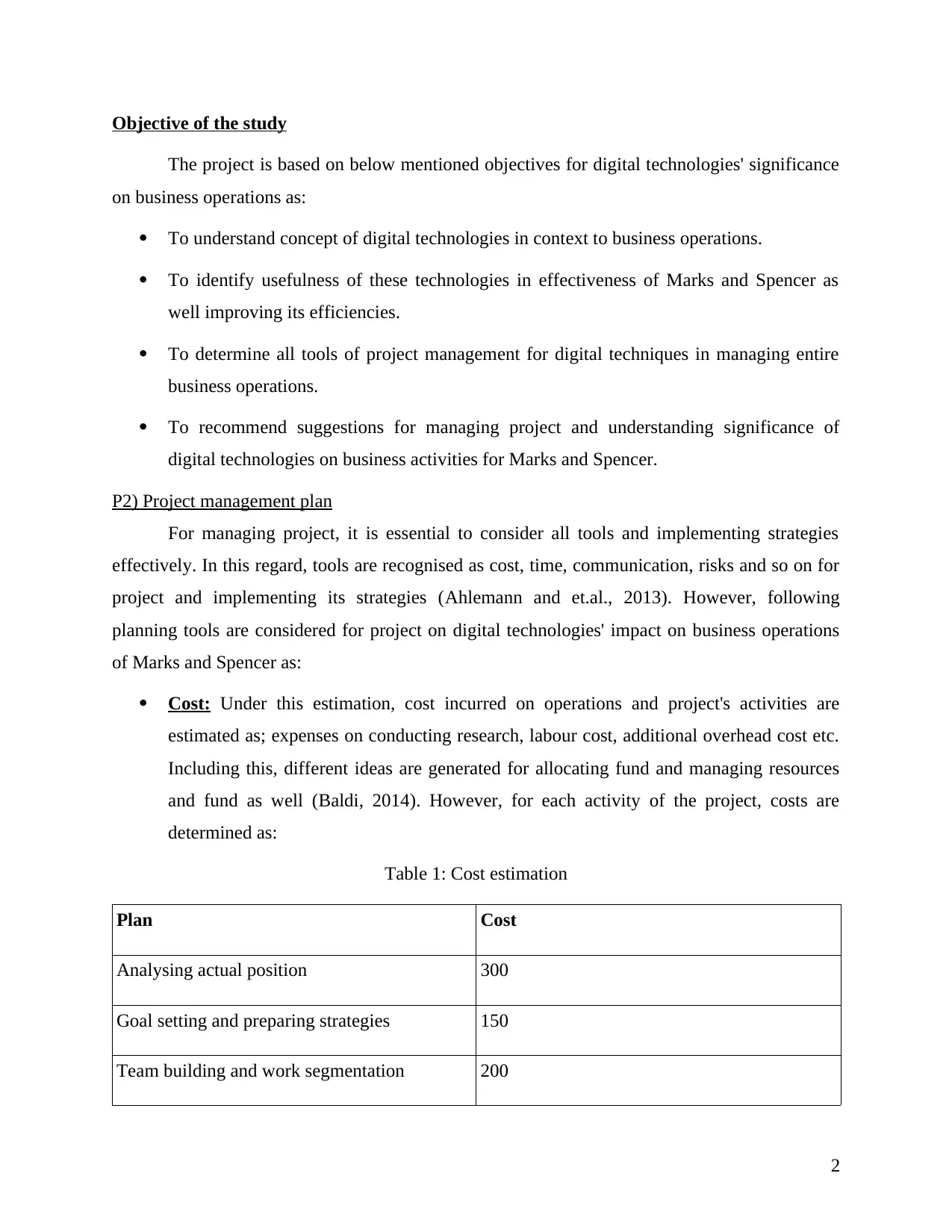
Objective of the study
The project is based on below mentioned objectives for digital technologies' significance
on business operations as:
To understand concept of digital technologies in context to business operations.
To identify usefulness of these technologies in effectiveness of Marks and Spencer as
well improving its efficiencies.
To determine all tools of project management for digital techniques in managing entire
business operations.
To recommend suggestions for managing project and understanding significance of
digital technologies on business activities for Marks and Spencer.
P2) Project management plan
For managing project, it is essential to consider all tools and implementing strategies
effectively. In this regard, tools are recognised as cost, time, communication, risks and so on for
project and implementing its strategies (Ahlemann and et.al., 2013). However, following
planning tools are considered for project on digital technologies' impact on business operations
of Marks and Spencer as:
Cost: Under this estimation, cost incurred on operations and project's activities are
estimated as; expenses on conducting research, labour cost, additional overhead cost etc.
Including this, different ideas are generated for allocating fund and managing resources
and fund as well (Baldi, 2014). However, for each activity of the project, costs are
determined as:
Table 1: Cost estimation
Plan Cost
Analysing actual position 300
Goal setting and preparing strategies 150
Team building and work segmentation 200
2
The project is based on below mentioned objectives for digital technologies' significance
on business operations as:
To understand concept of digital technologies in context to business operations.
To identify usefulness of these technologies in effectiveness of Marks and Spencer as
well improving its efficiencies.
To determine all tools of project management for digital techniques in managing entire
business operations.
To recommend suggestions for managing project and understanding significance of
digital technologies on business activities for Marks and Spencer.
P2) Project management plan
For managing project, it is essential to consider all tools and implementing strategies
effectively. In this regard, tools are recognised as cost, time, communication, risks and so on for
project and implementing its strategies (Ahlemann and et.al., 2013). However, following
planning tools are considered for project on digital technologies' impact on business operations
of Marks and Spencer as:
Cost: Under this estimation, cost incurred on operations and project's activities are
estimated as; expenses on conducting research, labour cost, additional overhead cost etc.
Including this, different ideas are generated for allocating fund and managing resources
and fund as well (Baldi, 2014). However, for each activity of the project, costs are
determined as:
Table 1: Cost estimation
Plan Cost
Analysing actual position 300
Goal setting and preparing strategies 150
Team building and work segmentation 200
2
⊘ This is a preview!⊘
Do you want full access?
Subscribe today to unlock all pages.

Trusted by 1+ million students worldwide
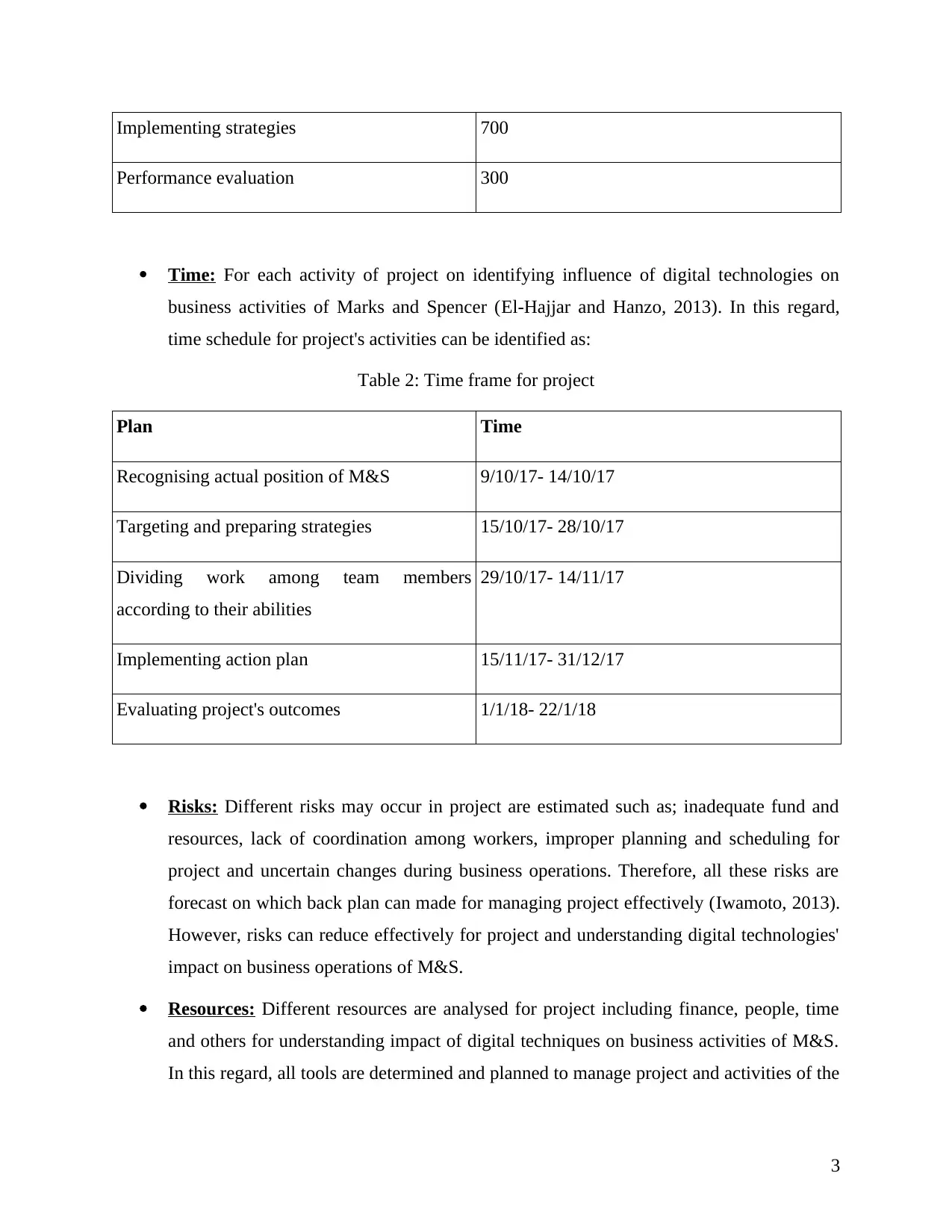
Implementing strategies 700
Performance evaluation 300
Time: For each activity of project on identifying influence of digital technologies on
business activities of Marks and Spencer (El-Hajjar and Hanzo, 2013). In this regard,
time schedule for project's activities can be identified as:
Table 2: Time frame for project
Plan Time
Recognising actual position of M&S 9/10/17- 14/10/17
Targeting and preparing strategies 15/10/17- 28/10/17
Dividing work among team members
according to their abilities
29/10/17- 14/11/17
Implementing action plan 15/11/17- 31/12/17
Evaluating project's outcomes 1/1/18- 22/1/18
Risks: Different risks may occur in project are estimated such as; inadequate fund and
resources, lack of coordination among workers, improper planning and scheduling for
project and uncertain changes during business operations. Therefore, all these risks are
forecast on which back plan can made for managing project effectively (Iwamoto, 2013).
However, risks can reduce effectively for project and understanding digital technologies'
impact on business operations of M&S.
Resources: Different resources are analysed for project including finance, people, time
and others for understanding impact of digital techniques on business activities of M&S.
In this regard, all tools are determined and planned to manage project and activities of the
3
Performance evaluation 300
Time: For each activity of project on identifying influence of digital technologies on
business activities of Marks and Spencer (El-Hajjar and Hanzo, 2013). In this regard,
time schedule for project's activities can be identified as:
Table 2: Time frame for project
Plan Time
Recognising actual position of M&S 9/10/17- 14/10/17
Targeting and preparing strategies 15/10/17- 28/10/17
Dividing work among team members
according to their abilities
29/10/17- 14/11/17
Implementing action plan 15/11/17- 31/12/17
Evaluating project's outcomes 1/1/18- 22/1/18
Risks: Different risks may occur in project are estimated such as; inadequate fund and
resources, lack of coordination among workers, improper planning and scheduling for
project and uncertain changes during business operations. Therefore, all these risks are
forecast on which back plan can made for managing project effectively (Iwamoto, 2013).
However, risks can reduce effectively for project and understanding digital technologies'
impact on business operations of M&S.
Resources: Different resources are analysed for project including finance, people, time
and others for understanding impact of digital techniques on business activities of M&S.
In this regard, all tools are determined and planned to manage project and activities of the
3
Paraphrase This Document
Need a fresh take? Get an instant paraphrase of this document with our AI Paraphraser
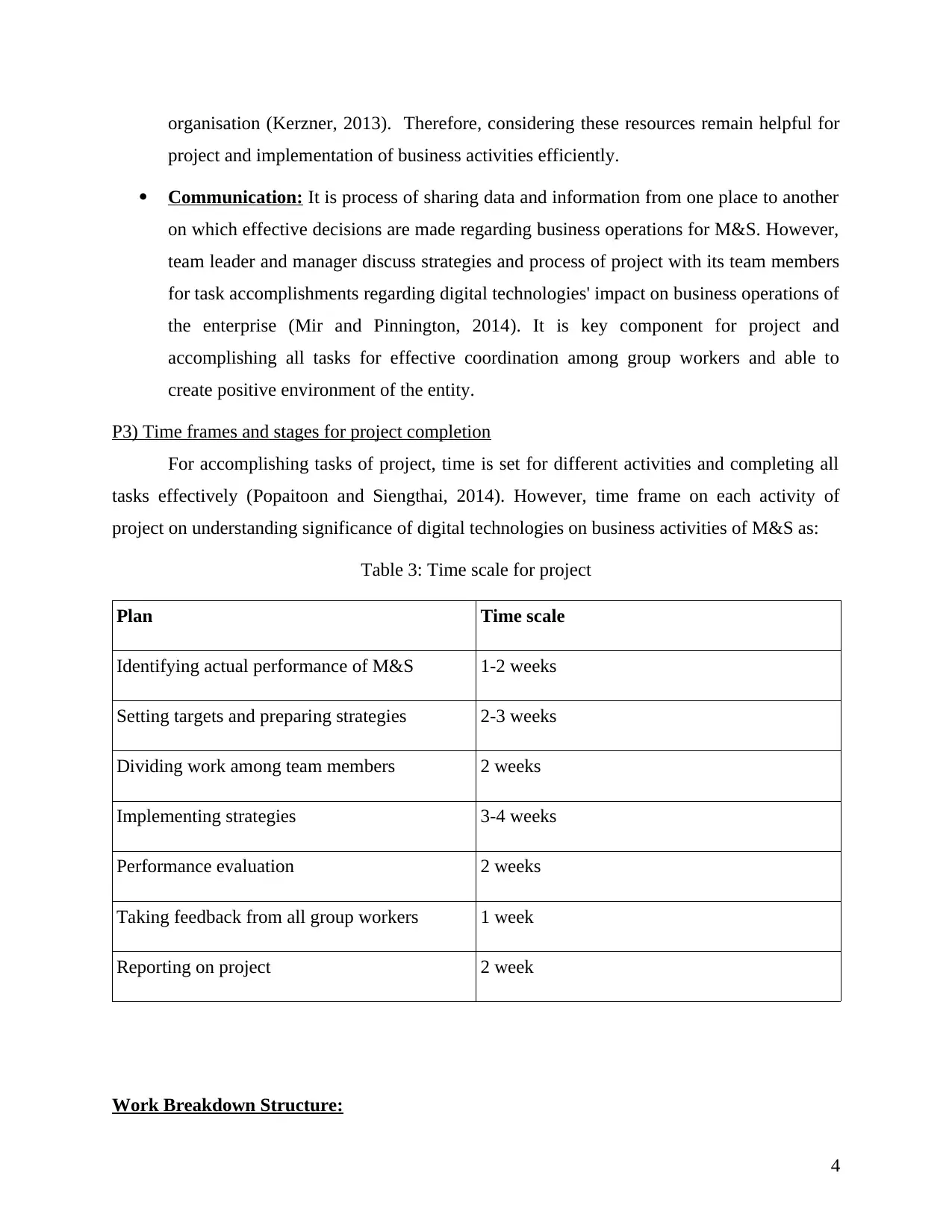
organisation (Kerzner, 2013). Therefore, considering these resources remain helpful for
project and implementation of business activities efficiently.
Communication: It is process of sharing data and information from one place to another
on which effective decisions are made regarding business operations for M&S. However,
team leader and manager discuss strategies and process of project with its team members
for task accomplishments regarding digital technologies' impact on business operations of
the enterprise (Mir and Pinnington, 2014). It is key component for project and
accomplishing all tasks for effective coordination among group workers and able to
create positive environment of the entity.
P3) Time frames and stages for project completion
For accomplishing tasks of project, time is set for different activities and completing all
tasks effectively (Popaitoon and Siengthai, 2014). However, time frame on each activity of
project on understanding significance of digital technologies on business activities of M&S as:
Table 3: Time scale for project
Plan Time scale
Identifying actual performance of M&S 1-2 weeks
Setting targets and preparing strategies 2-3 weeks
Dividing work among team members 2 weeks
Implementing strategies 3-4 weeks
Performance evaluation 2 weeks
Taking feedback from all group workers 1 week
Reporting on project 2 week
Work Breakdown Structure:
4
project and implementation of business activities efficiently.
Communication: It is process of sharing data and information from one place to another
on which effective decisions are made regarding business operations for M&S. However,
team leader and manager discuss strategies and process of project with its team members
for task accomplishments regarding digital technologies' impact on business operations of
the enterprise (Mir and Pinnington, 2014). It is key component for project and
accomplishing all tasks for effective coordination among group workers and able to
create positive environment of the entity.
P3) Time frames and stages for project completion
For accomplishing tasks of project, time is set for different activities and completing all
tasks effectively (Popaitoon and Siengthai, 2014). However, time frame on each activity of
project on understanding significance of digital technologies on business activities of M&S as:
Table 3: Time scale for project
Plan Time scale
Identifying actual performance of M&S 1-2 weeks
Setting targets and preparing strategies 2-3 weeks
Dividing work among team members 2 weeks
Implementing strategies 3-4 weeks
Performance evaluation 2 weeks
Taking feedback from all group workers 1 week
Reporting on project 2 week
Work Breakdown Structure:
4
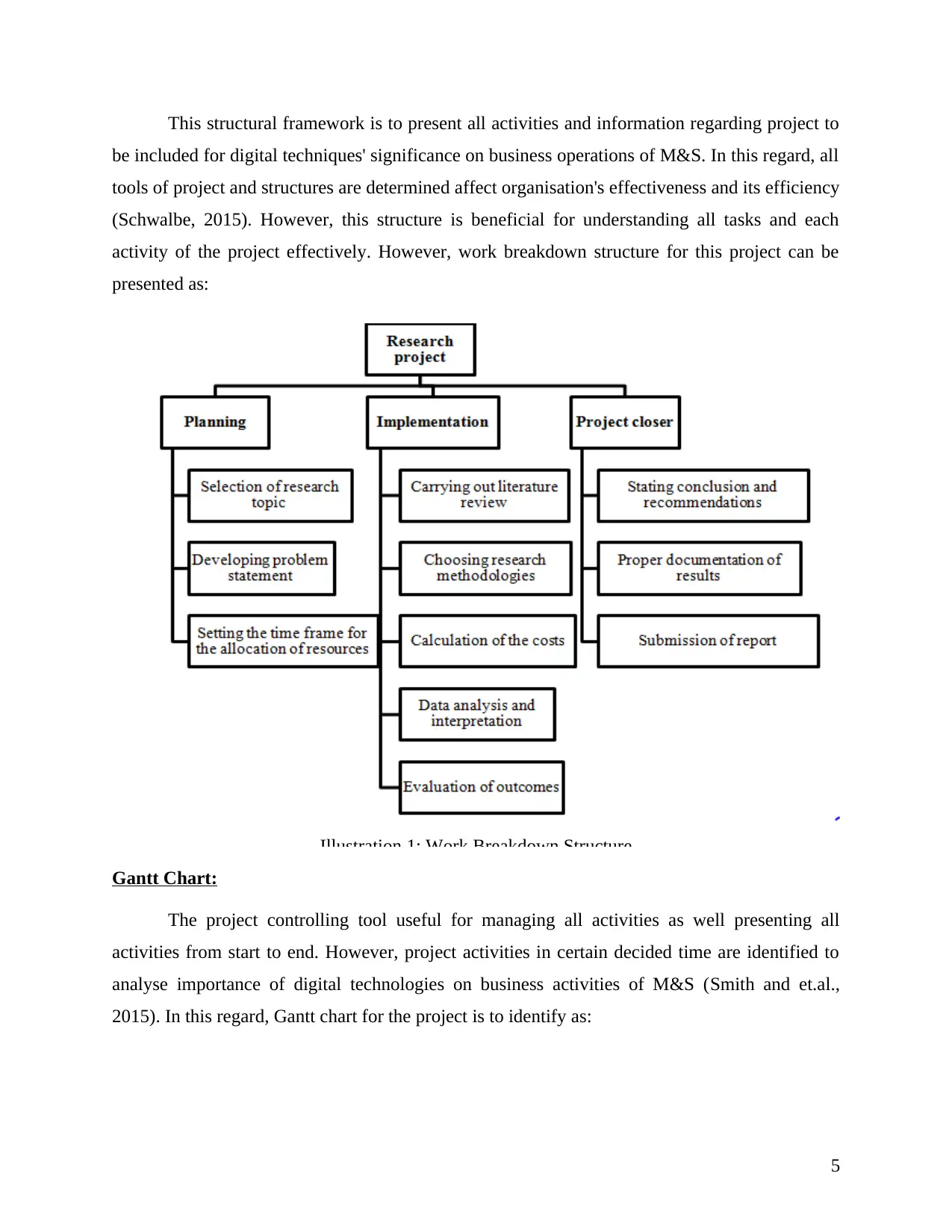
This structural framework is to present all activities and information regarding project to
be included for digital techniques' significance on business operations of M&S. In this regard, all
tools of project and structures are determined affect organisation's effectiveness and its efficiency
(Schwalbe, 2015). However, this structure is beneficial for understanding all tasks and each
activity of the project effectively. However, work breakdown structure for this project can be
presented as:
Illustration 1: Work Breakdown Structure
Gantt Chart:
The project controlling tool useful for managing all activities as well presenting all
activities from start to end. However, project activities in certain decided time are identified to
analyse importance of digital technologies on business activities of M&S (Smith and et.al.,
2015). In this regard, Gantt chart for the project is to identify as:
5
be included for digital techniques' significance on business operations of M&S. In this regard, all
tools of project and structures are determined affect organisation's effectiveness and its efficiency
(Schwalbe, 2015). However, this structure is beneficial for understanding all tasks and each
activity of the project effectively. However, work breakdown structure for this project can be
presented as:
Illustration 1: Work Breakdown Structure
Gantt Chart:
The project controlling tool useful for managing all activities as well presenting all
activities from start to end. However, project activities in certain decided time are identified to
analyse importance of digital technologies on business activities of M&S (Smith and et.al.,
2015). In this regard, Gantt chart for the project is to identify as:
5
⊘ This is a preview!⊘
Do you want full access?
Subscribe today to unlock all pages.

Trusted by 1+ million students worldwide
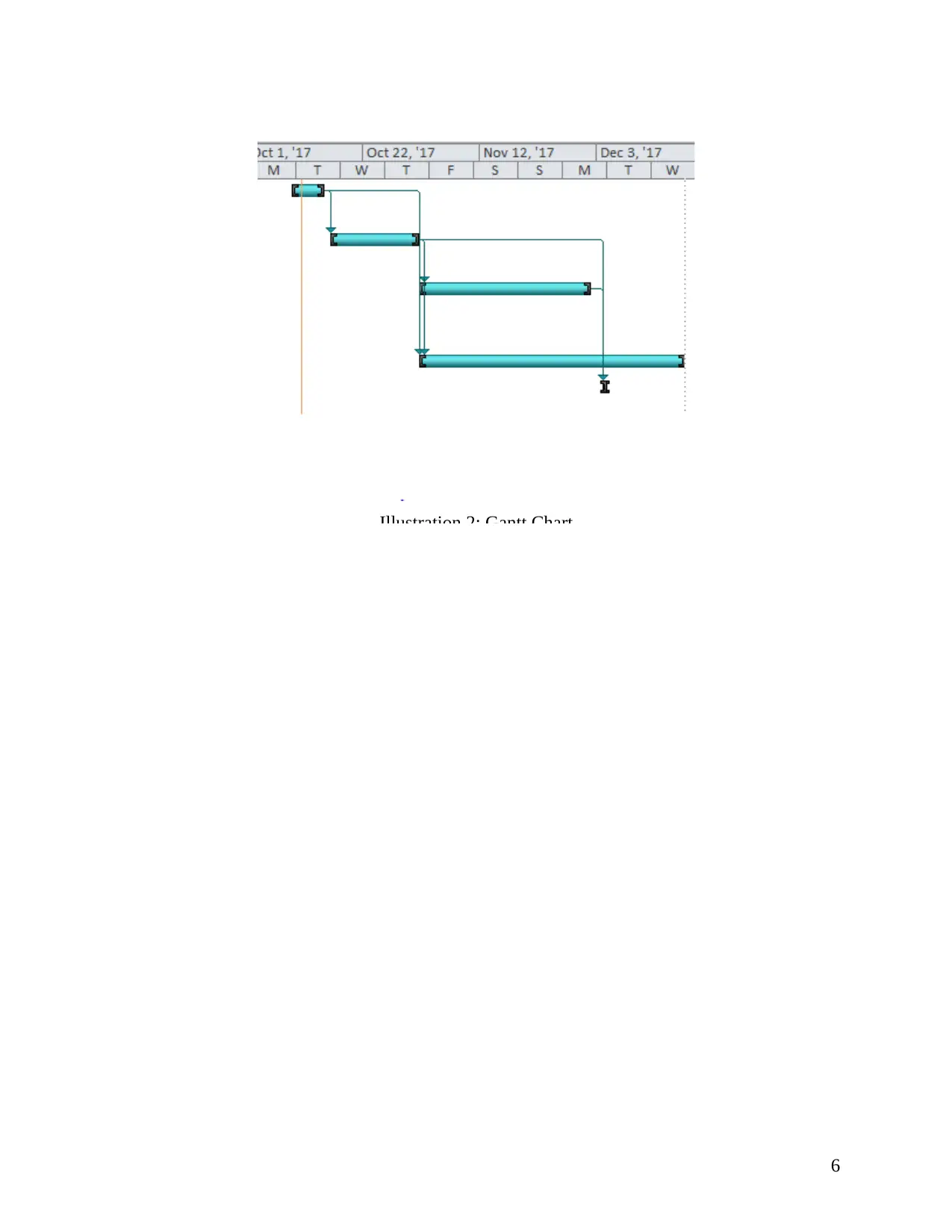
6
Illustration 2: Gantt Chart
Illustration 2: Gantt Chart
Paraphrase This Document
Need a fresh take? Get an instant paraphrase of this document with our AI Paraphraser
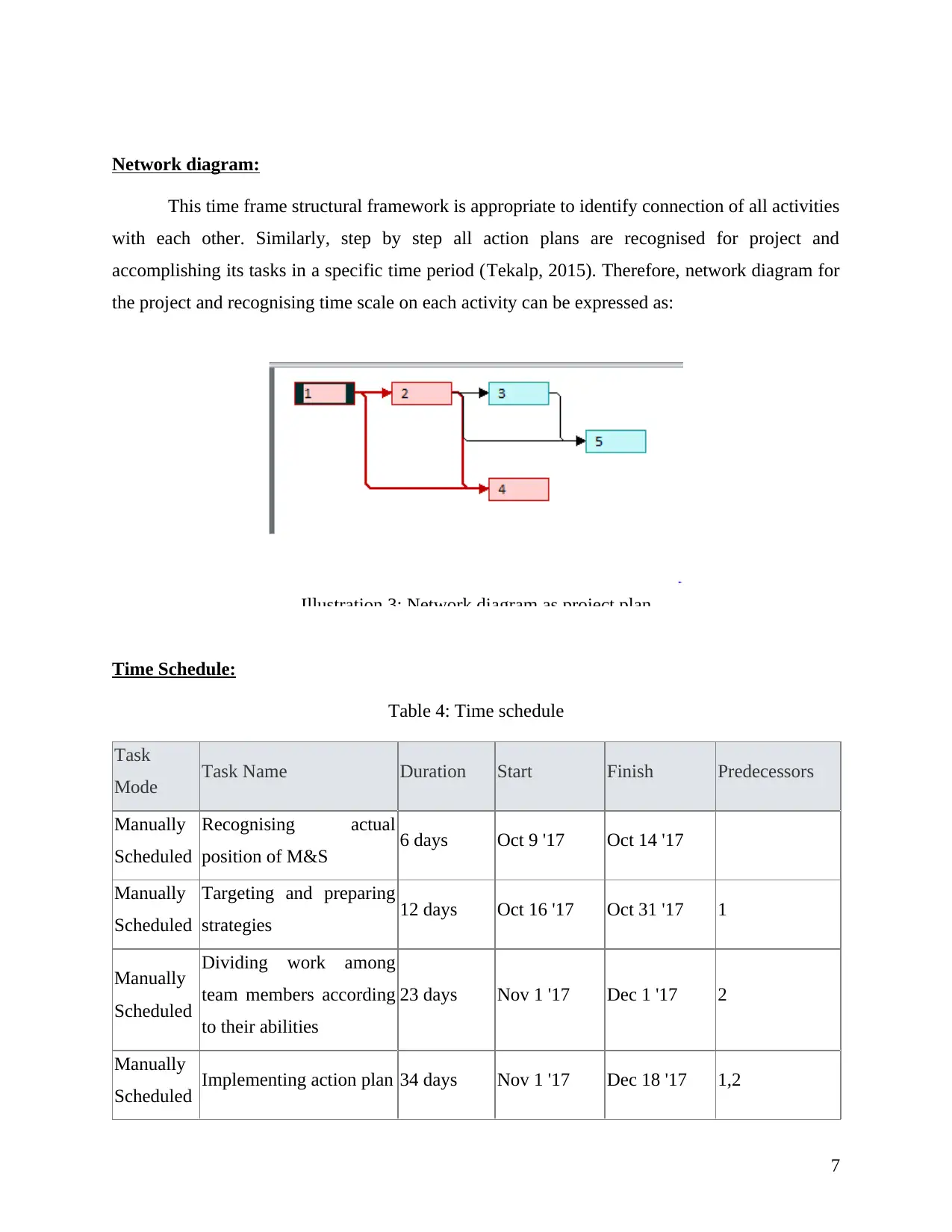
Network diagram:
This time frame structural framework is appropriate to identify connection of all activities
with each other. Similarly, step by step all action plans are recognised for project and
accomplishing its tasks in a specific time period (Tekalp, 2015). Therefore, network diagram for
the project and recognising time scale on each activity can be expressed as:
Time Schedule:
Table 4: Time schedule
Task
Mode Task Name Duration Start Finish Predecessors
Manually
Scheduled
Recognising actual
position of M&S 6 days Oct 9 '17 Oct 14 '17
Manually
Scheduled
Targeting and preparing
strategies 12 days Oct 16 '17 Oct 31 '17 1
Manually
Scheduled
Dividing work among
team members according
to their abilities
23 days Nov 1 '17 Dec 1 '17 2
Manually
Scheduled Implementing action plan 34 days Nov 1 '17 Dec 18 '17 1,2
7
Illustration 3: Network diagram as project plan
This time frame structural framework is appropriate to identify connection of all activities
with each other. Similarly, step by step all action plans are recognised for project and
accomplishing its tasks in a specific time period (Tekalp, 2015). Therefore, network diagram for
the project and recognising time scale on each activity can be expressed as:
Time Schedule:
Table 4: Time schedule
Task
Mode Task Name Duration Start Finish Predecessors
Manually
Scheduled
Recognising actual
position of M&S 6 days Oct 9 '17 Oct 14 '17
Manually
Scheduled
Targeting and preparing
strategies 12 days Oct 16 '17 Oct 31 '17 1
Manually
Scheduled
Dividing work among
team members according
to their abilities
23 days Nov 1 '17 Dec 1 '17 2
Manually
Scheduled Implementing action plan 34 days Nov 1 '17 Dec 18 '17 1,2
7
Illustration 3: Network diagram as project plan
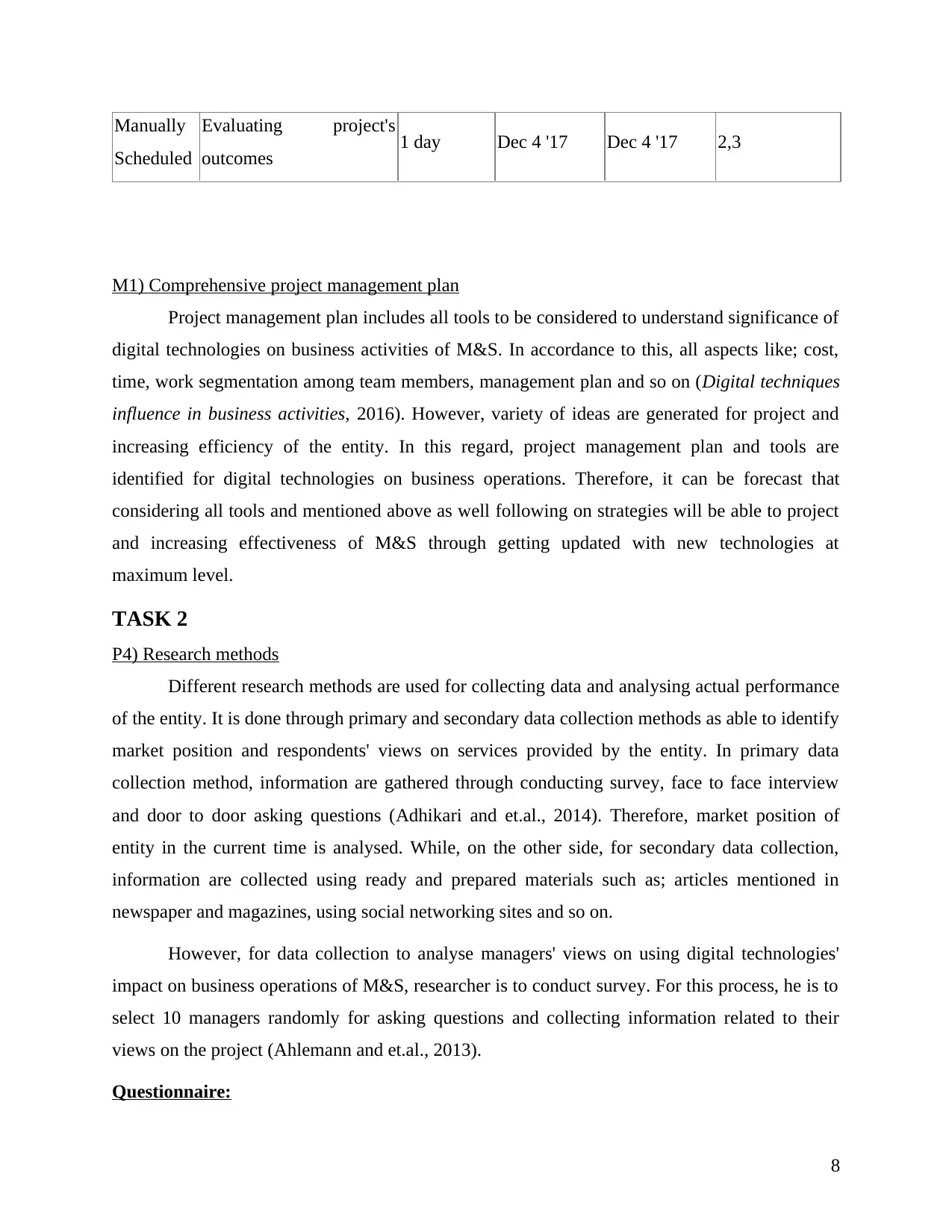
Manually
Scheduled
Evaluating project's
outcomes 1 day Dec 4 '17 Dec 4 '17 2,3
M1) Comprehensive project management plan
Project management plan includes all tools to be considered to understand significance of
digital technologies on business activities of M&S. In accordance to this, all aspects like; cost,
time, work segmentation among team members, management plan and so on (Digital techniques
influence in business activities, 2016). However, variety of ideas are generated for project and
increasing efficiency of the entity. In this regard, project management plan and tools are
identified for digital technologies on business operations. Therefore, it can be forecast that
considering all tools and mentioned above as well following on strategies will be able to project
and increasing effectiveness of M&S through getting updated with new technologies at
maximum level.
TASK 2
P4) Research methods
Different research methods are used for collecting data and analysing actual performance
of the entity. It is done through primary and secondary data collection methods as able to identify
market position and respondents' views on services provided by the entity. In primary data
collection method, information are gathered through conducting survey, face to face interview
and door to door asking questions (Adhikari and et.al., 2014). Therefore, market position of
entity in the current time is analysed. While, on the other side, for secondary data collection,
information are collected using ready and prepared materials such as; articles mentioned in
newspaper and magazines, using social networking sites and so on.
However, for data collection to analyse managers' views on using digital technologies'
impact on business operations of M&S, researcher is to conduct survey. For this process, he is to
select 10 managers randomly for asking questions and collecting information related to their
views on the project (Ahlemann and et.al., 2013).
Questionnaire:
8
Scheduled
Evaluating project's
outcomes 1 day Dec 4 '17 Dec 4 '17 2,3
M1) Comprehensive project management plan
Project management plan includes all tools to be considered to understand significance of
digital technologies on business activities of M&S. In accordance to this, all aspects like; cost,
time, work segmentation among team members, management plan and so on (Digital techniques
influence in business activities, 2016). However, variety of ideas are generated for project and
increasing efficiency of the entity. In this regard, project management plan and tools are
identified for digital technologies on business operations. Therefore, it can be forecast that
considering all tools and mentioned above as well following on strategies will be able to project
and increasing effectiveness of M&S through getting updated with new technologies at
maximum level.
TASK 2
P4) Research methods
Different research methods are used for collecting data and analysing actual performance
of the entity. It is done through primary and secondary data collection methods as able to identify
market position and respondents' views on services provided by the entity. In primary data
collection method, information are gathered through conducting survey, face to face interview
and door to door asking questions (Adhikari and et.al., 2014). Therefore, market position of
entity in the current time is analysed. While, on the other side, for secondary data collection,
information are collected using ready and prepared materials such as; articles mentioned in
newspaper and magazines, using social networking sites and so on.
However, for data collection to analyse managers' views on using digital technologies'
impact on business operations of M&S, researcher is to conduct survey. For this process, he is to
select 10 managers randomly for asking questions and collecting information related to their
views on the project (Ahlemann and et.al., 2013).
Questionnaire:
8
⊘ This is a preview!⊘
Do you want full access?
Subscribe today to unlock all pages.

Trusted by 1+ million students worldwide
1 out of 27
Related Documents
Your All-in-One AI-Powered Toolkit for Academic Success.
+13062052269
info@desklib.com
Available 24*7 on WhatsApp / Email
![[object Object]](/_next/static/media/star-bottom.7253800d.svg)
Unlock your academic potential
Copyright © 2020–2025 A2Z Services. All Rights Reserved. Developed and managed by ZUCOL.





